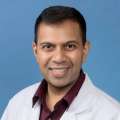As Kiran Kavipurapu, DO, steps onto a stage, he is overcome with anticipation that is mixed, in equal parts, with anxiety and excitement. But once he locks eyes with his audience, the music starts and he begins to twist his arms and hands and twirl his body to the rhythms of an Indian beat, all of that is stilled.
“I feel one with the music and love expressing myself in unique ways,” he says.
“Bollywood” dancing — a stylistic mash-up that blends traditional Indian folk, hip-hop, Arabic and jazz influences — has been Dr. Kavipurapu’s passion since he was a child. Growing up in a family that embraced arts and culture, he began when he was 6 years old.
His mother, a TV and radio artist before immigrating to the United States from India, got him started. She choreographed his dances, enrolled him in formal training and signed him up to perform at community cultural events. Dr. Kavipurapu, who today is assistant clinical professor of obstetrics and gynecology and director of the OB/GYN residency program in the David Geffen School of Medicine at UCLA, has been hooked ever since.
While an undergrad, he was a member of a competitive dance team. It was a commitment that had him practicing after classes, sometimes until four in the morning during the height of the competition season. Even while juggling all the demands on him — he was a premed student and also working toward a master’s degree in public health — dance practice never felt like a chore. If anything, “it was a release for me,” he says. “I never looked at it as a job.”
It did, in fact, become a job as he neared the end of his undergrad studies and prepared to enter medical school. He was hired into a professional troupe that performed at a variety of events, and was even brought in to consult and perform in a music video — replete with ornate saris and costumes, opulent jewelry and the complex hand gestures and dance moves that make Bollywood dancing a visually striking performance — by American-Venezuelan singer Devendra Banhart.
The Bollywood style is a feature of India’s Hindi film industry. The word itself is a portmanteau of Bombay (today called Mumbai) and Hollywood. The associated dance tells stories, whether they are drama or a light-hearted romp, through music and movement, and has dream-like qualities, often shifting on the screen from one location to the next — say, from a sand dune to a snow-topped peak — in an instant. “Bollywood dance tends to embrace that dream, asking what could we do if we spread our imagination beyond the confines of the normal life that we live in and its day-to-day struggles?” Dr. Kavipurapu says.
During his competitive and professional dancing days, Dr. Kavipurapu was able to spread his own imagination as a choreographer. He liked to incorporate different types of dances — Afro, Bollywood and jazz — into one unique piece, and he thrilled to the creative process of tweaking the choreography until it had achieved his grand vision. He also enjoyed watching as the dancers moved from skepticism about his choreographic ideas to embracing them. “It is rewarding to see your production on stage and the ‘wow!’ feeling that comes with it,” he says.
That feeling, Dr. Kavipurapu says, is available to everyone. One doesn’t need to be a professional dancer to experience the joy and calm that comes with moving your body and listening to music. He sees that is true in his own patients. Whether going into labor or preparing for an anxiety-provoking procedure, his patients often use music as a tool to destress and get in the zone.
Dr. Kavipurapu also encourages his patients to take up dancing during their pregnancy. It helps to prepare them for labor, he says, and the flexibility facilitates their baby moving into the proper pelvic position for a natural birth. “There is the stigma in women’s health that tells them when they are pregnant, they should take it easy. I take the opposite approach and tell them to listen to music and work out,” Dr. Kavipurapu says. One day, he would like to create a Bollywood dance class to help his patients engage in a fitness routine while pregnant.
While his time to pursue Bollywood dancing significantly diminished once he started clinical rotations in his third year of medical school — while simultaneously attending law school and earning a JD — Dr. Kavipurapu, to this day, still carves out time to perform at cultural events for Indian holidays like Diwali or Holi. He and his family are involved in the Telegu Association of Southern California, an organization that celebrates Telegu heritage and hosts an annual cultural event.
One day, he hopes to return to practicing and performing Bollywood dance on a regular basis. “I will never let go of it,” Dr. Kavipurapu says. “It is a huge part of me.”
Kelsie Sandoval is a senior media relations officer for UCLA Health. Before coming to UCLA, she was a member of the health-reporting teams for NBC News and the online news site Insider

